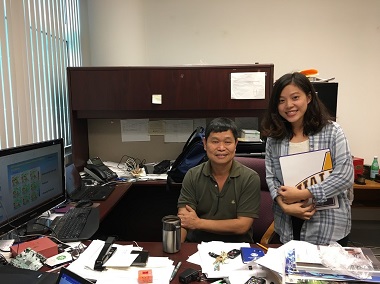PIRE Research Connects Air Pollution to Worst Taiwanese Drought in Nearly 60 Years

ALBANY, N.Y. (June 24, 2021) – A new study co-published by researchers at the University at Albany and National Central University (NCU) has linked air pollution to the worst drought that Taiwan has experienced in more than a half-century.
The study, published in the Journal of Atmospheric Chemistry and Physics, analyzed 13 years of satellite and surface to better understand how aerosols (air pollution) impact cloud lifecycle and precipitation during the autumn months over northern Taiwan. Their findings suggest that increasing levels of air pollution are indirectly reducing the amount of rainfall.
Data was analyzed from 2005 to 2017 on airborne particulate matter smaller than 2.5 micrometers. As aerosol concentrations rose, cloud droplets became smaller and more numerous, with drizzles occurring less frequently. “Polluted days,” defined as being in the 80th percentile or higher of the region’s average daily aerosol concentrations, saw about 6.8 millimeters less of average rainfall than “clean days” in the fixed cloud water content.
Taiwan is usually among the wettest places in the world, but with diminishing plum rain and typhoon seasons, it is facing its worst drought in 56 years. Many reservoirs are now at less than 20 percent capacity, some as low as 10 percent. These conditions are not only detrimental to the people living there, but also the global electronics sector, which relies heavily on the island for semiconductor manufacturing.
“These drought conditions are impacting people’s daily lives and industrial production,” said Qilong Min, a research associate at UAlbany’s Atmospheric Sciences Research Center (ASRC) and study co-author. “Scientists are trying to understand the linkage of the drought and other environmental factors. We’re looking closely at one of those environmental factors – aerosols in the atmosphere. Our analysis is showing a clear linkage that when air pollution is higher, it results in a decrease in the characteristics of rain droplets and frequency of drizzle events.”
The U.S. Taiwan Partnership

This research is part of the U.S.-Taiwan Partnership for International Research and Education (PIRE) project.
Announced by U.S. Senators Charles E. Schumer and Kirsten Gillibrand, the 5-year, $4.5 million project’s goal is to advance research in early warning detection and disaster response of major storms. It is led by UAlbany in partnership with several universities and disaster and weather forecast agencies in both the United States and Taiwan, including NCU.
Before the pandemic, dozens of students from participating institutions were offered travel and living expenses to study abroad and complete summer-long research internships under the mentorship of PIRE faculty at partnering institutions.
Lead study author Ying-Chieh Chen, a recent graduate of NCU’s Department of Atmospheric Sciences, was among the first cohort of the PIRE program in the summer of 2017. She studied at UAlbany for two months under the mentorship of Min, focusing on the aerosol impacts on cloud lifecycle and precipitation distribution in northern Taiwan through radiative and microphysical effects.
Chen wrote her thesis on the topic and has since earned her master’s degree. Following her summer exchange, she telecommunicated with Min during a three-year research process before publishing findings in late March.
“Through the PIRE project, I was grateful for the opportunity to work closely with a number of professional research professionals to better explore the relationship between aerosol-cloud precipitation interactions,” Chen said. “Our findings offer important insight into the environmental factors of one of the worst recorded droughts in Taiwan’s history.”
The study included more than a half dozen researchers from ASRC and NCU. They plan to continue exploring this topic with new cohorts of PIRE exchange students once the program resumes.




